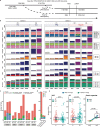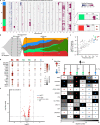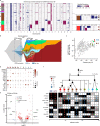Deterministic evolution and stringent selection during preneoplasia
- PMID: 37258665
- PMCID: PMC10247377
- DOI: 10.1038/s41586-023-06102-8
Deterministic evolution and stringent selection during preneoplasia
Abstract
The earliest events during human tumour initiation, although poorly characterized, may hold clues to malignancy detection and prevention1. Here we model occult preneoplasia by biallelic inactivation of TP53, a common early event in gastric cancer, in human gastric organoids. Causal relationships between this initiating genetic lesion and resulting phenotypes were established using experimental evolution in multiple clonally derived cultures over 2 years. TP53 loss elicited progressive aneuploidy, including copy number alterations and structural variants prevalent in gastric cancers, with evident preferred orders. Longitudinal single-cell sequencing of TP53-deficient gastric organoids similarly indicates progression towards malignant transcriptional programmes. Moreover, high-throughput lineage tracing with expressed cellular barcodes demonstrates reproducible dynamics whereby initially rare subclones with shared transcriptional programmes repeatedly attain clonal dominance. This powerful platform for experimental evolution exposes stringent selection, clonal interference and a marked degree of phenotypic convergence in premalignant epithelial organoids. These data imply predictability in the earliest stages of tumorigenesis and show evolutionary constraints and barriers to malignant transformation, with implications for earlier detection and interception of aggressive, genome-instable tumours.
© 2023. The Author(s).
Conflict of interest statement
Unrelated to this study, C.J.K. is a founder and stockholder for Surrozen, Inc., Mozart Therapeutics and NextVivo, Inc. and C.C. is a stockholder in Illumina and DeepCell and an advisor to DeepCell, Genentech, Bristol Myers Squibb, 3T Biosciences, NanoString and ResistanceBio. The remaining authors declare no competing interests.
Figures
















References
-
- Crosby D, et al. Early detection of cancer. Science. 2022;375:eaay9040. - PubMed
-
- Lenski RE, Rose MR, Simpson SC, Tadler SC. Long-term experimental evolution in Escherichia coli. I. Adaptation and divergence during 2,000 generations. Am. Nat. 1991;138:1315–1341.
Publication types
MeSH terms
Substances
Grants and funding
LinkOut - more resources
Full Text Sources
Medical
Research Materials
Miscellaneous

